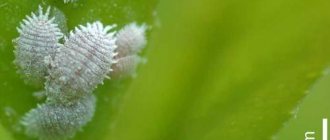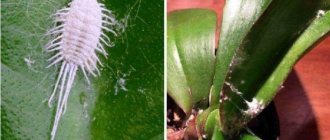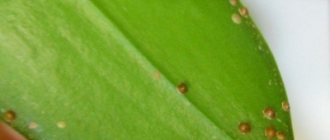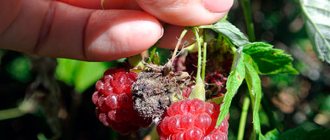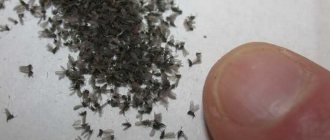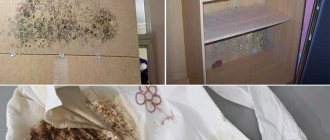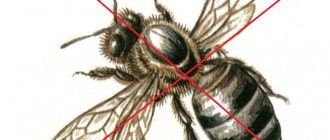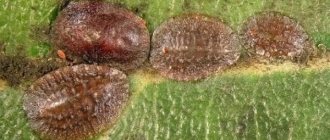With improperly organized care, the orchid is completely a harmful insect may appear mealybug.
It, feeding on the sap of the plant, methodically destroys the foliage and roots of the plant. If urgent measures are not taken, the flower may die.
Below we will tell you in detail how to get rid of mealybugs on an orchid. But first, let’s find out what kind of pest this is.
Description of the pest
The pest belongs to the hemiptera family and is a close relative of the scale insect. Both species are sap-sucking pests.
Types and popular name
This representative of the pest is popularly called white lice. And now science knows more than 1,600 species of these insects that live on various plants. In the photo you can see one of the common types of mealybug.
There are many types of mealybug.
Here are the few species that can be found on an orchid:
- Bristly - has a dense coat and longer hind legs;
- Primorsky - this species is the most prolific, as females lay 400 eggs in one clutch;
- Grape - lives in the southern regions of Russia, and females are colored brown.
IMPORTANT! Whatever mealybug appears on the orchid, it must be eliminated as quickly as possible, otherwise the plant will die.
Description of the adult and larva
In appearance, the insect is similar to the scale insect, but, unlike it, is not covered with a shell and has a white body color. The insect is very mobile and therefore, if it is noticed on one orchid, the plant should be immediately isolated in a quarantine zone, and the remaining orchids should be carefully examined for the presence of the pest.
The mobility of an insect does not depend on its age . Depending on the species, the size of the mealybug can be from 3 to 12 mm.
Male:
- Has wings;
- Well developed limbs;
- It has 2 tail filaments on the abdomen;
- Does not have an oral cavity (do not eat during their life).
Female:
- Has an oral cavity;
- Some species do not have legs;
- They have a cotton-like sac from which live larvae emerge, which are very mobile immediately after birth.
Larva:
- Mobile for some time before molting;
- Then it sticks to the leaf and will remain motionless until molting occurs;
- It has a white body color and looks like a small worm.
IMPORTANT! The female begins her reproduction only in secluded places of the plant, for example in the leaf axils.
Damage to the plant
Under the conditions necessary for it, the mealybug quickly spreads throughout the orchid. If the disease is detected in the initial stage, treatment will be faster and more effective. By feeding, the harmful insect harms the plant :
- Deprives the nutritional juice necessary for uniform development;
- The plant is stunted;
Mealybugs cause the orchid leaves to turn yellow. - Foliage damaged by bites takes on a yellow tint;
- The plaque left by the scale insect attracts fungal and bacterial diseases.
It is necessary to take treatment measures in a timely manner so as not to lose the plant.
Traditional methods of treatment
Gardeners are moving away from using chemicals to treat orchids from scale insects. This is due to the fact that no one wants to once again expose plants to the toxic effects of chemicals. After such treatment, they become weak and painful; in such cases, it is quite difficult to establish intensive growth and development of the flower. The following folk recipes are known among gardeners:
- Prepare a garlic-based solution by adding ten cloves to 300 milliliters of boiled water. First you need to crush them in a garlic press, mix the mixture thoroughly. Water the affected part of the orchid with the resulting solution once a day for 14 days;
- Use horsetail tincture to spray the plant. Before carrying out this procedure, dilute the purchased horsetail in 500 milliliters of liquid. Let the solution sit for one day. Water the affected areas several times a day. The course of treatment is 10 days, if necessary it can be increased until the insect completely disappears.
Prevention of infection
If you don't want your plant to become infested with mealybugs, there are a few precautions you can take. These include maintaining required care and following all regulations. Do not water the plant too often and abundantly, monitor the air temperature in the room and remove dried leaves in a timely manner. Follow these simple rules, and your orchid will not get sick and will remain beautiful.
Currently reading:
- Seven types of pears for planting, caring for and growing fruits
- Top 4 Types of Best Green Asplenium House Ferns
- Causes of rust on leaves and methods of control
- Growing, care, wintering of African chamomile gatsaniya
Share the news on social networks
About the author: Victoria Semyonovna Nakhodkina
Leading researcher at the laboratory of vegetable and berry crops, Yakut Scientific Research Institute of Agriculture, Siberian Branch of the Russian Academy of Agricultural Sciences, Republic of Sakha (Yakutia).
Infection
Symptoms
To determine what kind of pest an orchid is affected by, it is necessary to diagnose it correctly , and for this you need to know the signs of damage to the plant.
The scale insects gather in groups in the axils of leaf blades and their undersides.
The scale insect can be seen with the naked eye, as the length of its body is quite noticeable. First of all, these are cotton bags where the female parasites lay their clutches. The plant seems to be covered with cotton balls.
How does infection occur?
You can introduce a pest:
- By purchasing an already infected plant specimen in a store;
- Or bring larvae from contact with infected flowers.
Therefore, newly purchased flowers are always placed in a quarantine zone to be sure that they are free of pests.
Causes
Possible reasons why an orchid may become infected:
- Constant bays of plants;
Mealybugs often appear due to overwatering or low temperatures. - Low temperatures;
- When dead parts of a plant are removed at the wrong time.
IMPORTANT! To prevent the plant from being attacked by a pest, it must be properly cared for.
External signs
Initially, the insect is located only in the axils of the leaves. But in the process of its reproduction it spreads very quickly throughout the entire plant, covering it with a cottony coating :
- Flowers;
- Peduncles;
- Leaves;
- Then its larvae fall into the ground and begin to destroy the root mass.
The infected flower is evenly covered with cotton balls in which pests grow.
How to protect your pets from unwanted attacks?
First, provide growing conditions that exclude the pest’s optimal habitat, namely, the required air humidity, the required lighting, and optimally adjusted watering and fertilizing regimes.
Secondly, regularly inspect the orchids in your collection and promptly remove leaf plates that have dried naturally; they often become objects of hiding for scale insects. Orchids should be bathed regularly in a warm shower.
Finally, purchased new plants must be quarantined in isolation from the rest of the orchid collection, and soil mixtures or substrates for epiphytes brought from the store must be disinfected by baking in the oven or pouring boiling water over them.
Fighting methods
How to deal with mealybugs so as not to greatly harm the orchid?
Physical methods
Physical pest control measures can be used. If the infection is in the initial stage, then the harmful insect can be gotten rid of mechanically without using chemicals.
Methodology
How to cure an orchid physically? To remove the parasite from the leaf mass, you will need :
- Cotton pad;
- Or a soft toothbrush.
They are moistened in soapy water and the orchid is carefully washed from the cotton balls. In hard-to-reach places, you can use cotton swabs, since before treatment you need to carefully get rid of all insects.
Hot shower
There are different ways to remove mealybugs on flower buds. One of them is watering the orchid with a hot shower.
The water temperature, comfortable for orchids, should not exceed 30 degrees . This can be easily determined by placing your hand under running water. If water is pleasant for a person in terms of warmth, then the orchid will like it. But the thermometer is still more accurate
